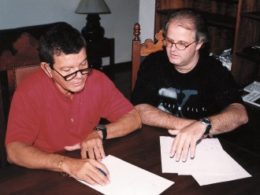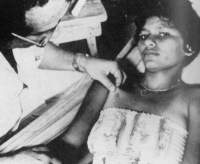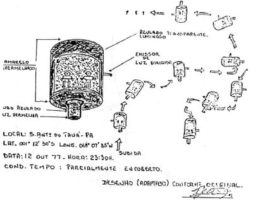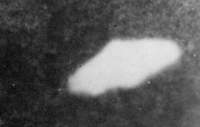by Charles Lear
This is the third in a series examining the rather grim subject of UFO related injuries. While we don’t want to dwell on this aspect of the mystery too extensively, it would be remiss to leave the subject without exploring what happened in Brazil in 1977. The events there were extraordinary, as was the investigation by the Brazilian Air Force. Fortunately, it was not the start of a trend in UFO contact, for had it been, many of us might be considerably more anxious.
From April 1977 into 1978, there was a flap over the Amazon Delta in the northeast section of Brazil. Because it involved reports of attacks and injuries, the Brazilian Air Force was moved to put together a special operation to deal with it. It was designated “Operação Prato”, which is Portuguese for “Operation Plate.”
 The name was chosen by Captain Uyrangê Hollanda. He explained his choice to researchers Ademar José Gevaerd and Cynthia Luce. Because he was not able to use the expressions, “flying saucer” or “flying disk,” he “chose a cousin of a saucer, a plate.” According to him, the expression in Portugal is “flying plate.” The popular expression in Brazil is “discos voadors.”
The name was chosen by Captain Uyrangê Hollanda. He explained his choice to researchers Ademar José Gevaerd and Cynthia Luce. Because he was not able to use the expressions, “flying saucer” or “flying disk,” he “chose a cousin of a saucer, a plate.” According to him, the expression in Portugal is “flying plate.” The popular expression in Brazil is “discos voadors.”
Hollanda was head of operations for A2, the intelligence branch of the Air Force. The operation was lead by him, and he had a team of six sergeants. Their equipment consisted of a theodolite, tape recorders and cameras. They were sent to the city of Belém, after the mayors of several surrounding villages complained of UFO attacks on their citizens.
 The most intense activity was concentrated to the north, around the village of Colares. The team investigated for four months and compiled a report consisting of around 500 pages. Included in the report are sketches, taped interviews, hundreds of UFO photos and four motion picture films. The report was classified until 2005, but photocopies of some documents and at least 18 photos were leaked to researchers over the years.
The most intense activity was concentrated to the north, around the village of Colares. The team investigated for four months and compiled a report consisting of around 500 pages. Included in the report are sketches, taped interviews, hundreds of UFO photos and four motion picture films. The report was classified until 2005, but photocopies of some documents and at least 18 photos were leaked to researchers over the years.
As a result of a 2004 effort started by Gevaerd to get Air Force UFO files released to the public, on May 20, 2005, researchers were invited to view selected documents, and these included some from Operação Prato. The case file is now available in Portuguese at the Brazilian National Archives. Some of the documents have been translated and are available at theblackvault.com.
 Colares, then a village and now a city, is located on Colares Island. There, as with reports from elsewhere, glowing forms of all shapes and sizes were seen to come in from the north after nightfall. At times, creatures were seen occupying the UFOs, or associated with them. Villagers were so frightened, the women and children were sent away at night, while the men kept armed vigils.
Colares, then a village and now a city, is located on Colares Island. There, as with reports from elsewhere, glowing forms of all shapes and sizes were seen to come in from the north after nightfall. At times, creatures were seen occupying the UFOs, or associated with them. Villagers were so frightened, the women and children were sent away at night, while the men kept armed vigils.
The most disturbing aspect was that people reported being hit by beams of light that paralyzed them momentarily and left them feeling enervated afterwards. Men were left with burns on the neck and women with burns on the chest. Tiny punctures were seen in some of the burns. Some suspected that they’d had blood taken from them, and many villagers started calling the UFOs “chupas” or “chupa chupas.” Chupa means “to suck” in both Spanish and Portuguese.
 The person who witnessed the aftermath of many of the “attacks” was Wellaide Cecim Carvalho. She was a 22-year-old nurse at the time and said she treated more than 100 villagers. She was interviewed in 2005 by Carlos Mendes, a journalist from the newspaper O Liberal. According to her, after more than 120 cases, she reported what was happening to her superiors. They didn’t believe her, and she was told by them to discourage the idea that something strange was happening. Officials from the Air Force told her to tell people that those affected were victims of mass hysteria.
The person who witnessed the aftermath of many of the “attacks” was Wellaide Cecim Carvalho. She was a 22-year-old nurse at the time and said she treated more than 100 villagers. She was interviewed in 2005 by Carlos Mendes, a journalist from the newspaper O Liberal. According to her, after more than 120 cases, she reported what was happening to her superiors. They didn’t believe her, and she was told by them to discourage the idea that something strange was happening. Officials from the Air Force told her to tell people that those affected were victims of mass hysteria.
Carvalho knew better, having seen UFOs herself. According the Operação Prato files, she “affirmed” that, on two separate occasions, she saw a “bright metallic object” spinning over the village. Whether it was the same object or two different objects, the shape was that of a truncated cone and the movement consisted of sudden starts and stops while rocking. She told Mendes that she’d seen a ship with a being, 1.2 or 1.3 meters tall. Hollanda and his team witnessed many UFOs themselves.
The first UFOlogist on the scene was Daniel Rebisso Giese, and he wrote the first book on the subject, “Extraterrestrial Vampires of the Amazon,” with the help of Wellaide. Robert Pratt also traveled to the area and investigated extensively.
Hollanda was interviewed by Gevaerd in Aug. 1997, for the magazine Revista UFO. He provided some of the most dramatic accounts. He told Gevaerd that they warned the villagers not to shoot at the objects. A man, who was “50 or 60 years old,” ignored the advice and shot at a strange light with his rifle. Light enveloped him and he fell to the ground. He was nearly paralyzed and had difficulty moving for the next 15 days.
Two accounts were from Baia do Sul, an area to the south of Colares. Hollanda describes one instance, where witnesses told him they’d watched, as a couple of beings shot at a woman with a “light-beam pistol” that left her unconscious for “several minutes.” The other event he described from that area involved a woman, Claudomira Paixao, who said she was awakened by a “strange light” that came through the window of her house. The light was green at first, and the air became warm. The light covered her face and then became red. She then saw a creature wearing what resembled a diving suit. It aimed what looked like a pistol at her. The “pistol” blinked three times. She then felt a hot pain in her breast along with the feeling that needles were piercing her and thought that some of her blood had been taken. She was terrified and unable to move her lips to scream.
Soon after his interview, Hollanda was found hanged in his house by his own bathrobe belt on Oct. 2, 1997. His relatives and many UFOlogists suspected there was foul play involved. Gevaerd told BBC Brasil, “I don’t believe in ‘witness elimination’ or conspiracy theory. He had attempted suicide before.” (sic)
Another conspiracy theory grew up around the death of Flávio Costa, one of the sergeants on the team. Costa was the person who wrote most of the reports. One of the witnesses in the report was Ubiratan Pińon Friás, a commercial pilot and resident of Belém. In 2005, Friás was interviewed for the online magazine UFOVIA by Vitório Peret. In the interview, he tells Peret that he, Hollanda, and Costa all had implants. Peret brings up a 1997 interview for Revista UFO (nºs 56 and 57 – CBPDV, 1997), where Hollanda talked about Costa having an implant in his thigh and bleeding from there. Friás corrects him, saying that Hollanda and Costa had implants in their left forearms and adds that his own is in the sole of his foot. He says that Costa died after waking up sad one day and never recovering. According to him, it looked like Costa had a stroke, but he really died because his “mission” had come to an end.
Costa’s son, Fernando, refutes this in an interview for the online magazine Vigila. He says that Friás’ “claims are imaginative and complete lies.” According to him, his father died of a heart attack following a stroke. When asked about his opinion regarding the UFOs and Operação Prato, he says, “The occurrence of a strange phenomenon is undeniable.”
This case was investigated by many UFOlogists, including Jaques Vallée. Despite the fact that the Operação Prato files were classified until recently, investigators were able to gather a huge amount of information. Like many tales in UFOlogy, this one is complicated and has its twists and turns. A good place to start for those interested in exploring further is UFOs at Close Sight, maintained by Patrick Gross. In the meantime, one should always approach UFOs with caution and think twice before shooting.